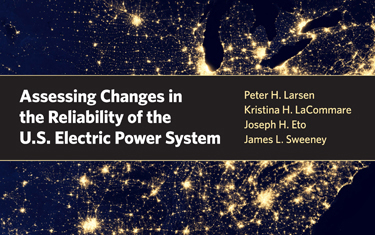August 24, 2015
Increasingly severe weather linked to longer-lasting power outages
This press release was adapted from a Lawrence Berkeley National Laboratory press release.
Electric power outages have not become more common since 2000, but when U.S. customers are without electricity they must wait a lot longer for the lights to come back on, according to a new study.
 Severe weather is the principal driver behind longer-lasting blackouts, according to researchers at Stanford University and Lawrence Berkeley National Laboratory. The average duration of outages increased every year over the period studied, 2000 to 2012, which included hurricanes Katrina and Sandy. Long outages correlated most strongly with strong winds, but also with greater amounts of rain and warmer weather. Severe weather is the principal driver behind longer-lasting blackouts, according to researchers at Stanford University and Lawrence Berkeley National Laboratory. The average duration of outages increased every year over the period studied, 2000 to 2012, which included hurricanes Katrina and Sandy. Long outages correlated most strongly with strong winds, but also with greater amounts of rain and warmer weather.
“Increasingly severe weather events are linked to a 5 percent to 10 percent increase in the total number of minutes customers are without power each year,” said lead author Peter H. Larsen, a PhD candidate in Stanford’s Department of Management Science & Engineering.
The researchers analyzed data from utilities serving nearly 70 percent of U.S. electricity customers. Their report, “Assessing Changes in the Reliability of the U.S. Electric Power System,” is available here from Lawrence Berkeley National Laboratory.
Although a 2013 White House report noted that major power outages and severe weather events are increasing, the new study is the first to use econometric analysis techniques to statistically correlate these events with electricity reliability. Most studies of reliability have relied on information that reflects only the largest power outages. Yet, over the course of any given year, the largest events typically account for no more than 10 percent of all power outages. This study, by relying on information for all power outages, both large and small, conclusively identifies a trend that is linked directly to these larger events.
Surprisingly, the study did not find a consistent link between reliability and utility transmission and distribution expenditures. “We expected to find that increased spending on T&D would lead to improved reliability, but it is possible that a combination of proactive versus reactive utility maintenance policies may be off-setting this effect on reliability,” Larsen said. He anticipates that future research will be able sort this out through more detailed analysis of utility spending practices.
"Utilities don’t seem to be failing to maintain the grid over time, but something is making these events more severe," said co-author James L. Sweeney, a professor of management science and director of the Precourt Energy Efficiency Center at Stanford. "To me, it's consistent with what you would see with climate change."
Climate change was not one of the specific variables the study examined, Sweeney said, but the findings align with expectations of more severe weather in a warming world.
Other co-authors were Kristina H. LaCommare and Joseph H. Eto of Berkeley Lab. This work was funded by the Office of Electricity Delivery and Energy Reliability, National Electricity Delivery Division of the U.S. Department of Energy.
Media Contact: Mark Golden, (650) 724-1629, mark.golden@stanford.edu
|
